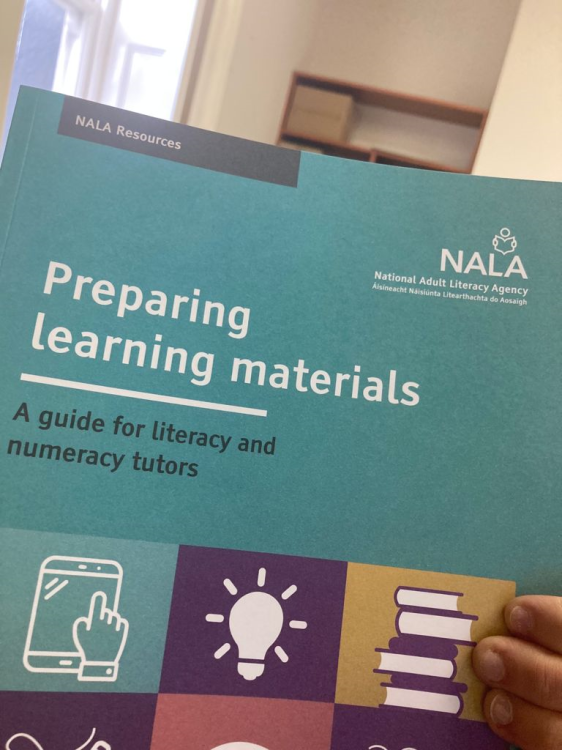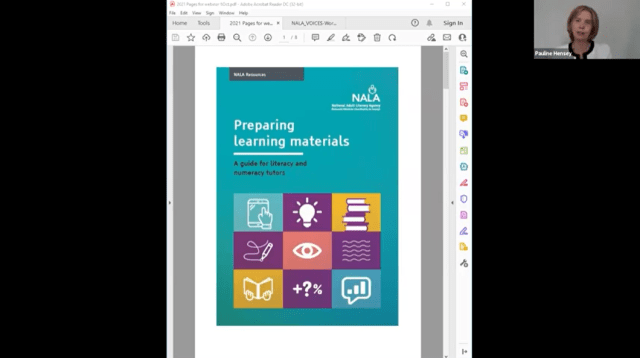
Planning and Writing Materials
Preparing Learning Materials - New course and tutor guide
Preparing Learning Materials Tutor Guide
Preparing Learning Materials is a guide for adult literacy and numeracy tutors. It gives guidelines and practical ideas for creating, writing and design of learning materials for adult literacy, numeracy and digital literacy work. It is an updated version of an earlier guide.
Find out more about the tutor guide
Preparing Learning Materials online course
This online Professional Development course on our eLearning website learnwithnala.ie is designed to help adult literacy tutors to prepare and design learning materials. It looks at the context for developing materials as well as how to plan, design, format and write learning materials. The course gives tips on adapting and simplifying materials and at the end of the course there are sample materials that you can view and download. The course takes about 1 hour to complete. You will receive a NALA Professional Development certificate on successful completion of this course.
Watch our webinar below to find out more about the new course and tutor guide.
Find out more about the online course

Preparing Learning Materials webinar
In this webinar we shared some useful resources and training for adult literacy tutors on preparing learning materials.
Planning and writing materials
Setting out
Ask yourself the following questions:
- Who will be using the materials? Are they for a specific group or groups of students or are they for general use?
- Is there a specific context the materials will be used in? For example, are they for use with groups or in a one-to-one setting; for face-to-face learning or for distance learning; with youth groups or in a work – based learning setting?
- How much do you know about your intended student? How do you find out?
- Are there existing relevant materials to consider?
- Is there a clear set of learning aims and objectives? How will these be conveyed to the learner?
Learning materials: some points to consider
Learning materials should show variety, suit different levels, be relevant and be enjoyable.
- They should be culturally appropriate and inclusive.
- They are most useful when they reinforce and build on what the student already knows and can do.
- Keep level/s of literacy and numeracy in mind. The Mapping the Learning Journey (MLJ) framework identifies three broad levels of literacy and numeracy tasks: beginning, mid and upper. It takes account of the ‘spikiness’ of levels: for example, a worksheet could be at the beginning level of writing, the mid-level of reading, and the upper level of range of application. We can also identify literacy and numeracy levels with reference to FETACawards, particularly Levels 1, 2 and 3. Keeping levels of literacy and numeracy in mind is useful when designing materials for publication or for general use. When designing for a particular student or group, the main aim is to pitch the materials at the level appropriate for their particular goals and needs.
- Include materials that allow students to show progress in their skills outside the classroom setting. These should include tasks and activities that encourage students to use reading, writing, numeracy and communication skills in their daily lives. The four cornerstones of learning identified in the MLJframework might be a useful reference point. They remind us to develop materials that support learning and progress in:
- knowledge and skills;
- depth of understanding and critical awareness;
- fluency and independence; and
- range of application.
- Where students are working towards accreditation, it would be useful to state on the text or worksheet how it could relate to a particular part of that process. For example, some worksheets might provide evidence for a range of FETAC
- Whenever we adapt worksheets, materials and texts from other sources, we must acknowledge that source and in some cases get permission to use the material.


Helping learners engage with the materials
There are a number of things you can do to help learners engage fully with the materials.
Learn More
English for Speakers of Other Languages (ESOL)
Include themes and exercises relevant to the students’ culture.
Learn More


Numeracy
When writing materials for numeracy teaching there are additional concerns to keep in mind.
Learn More
Design considerations
The design of learning materials is just as important as the content.
Learn More


